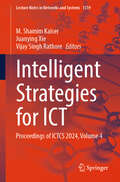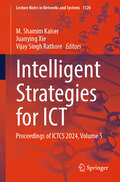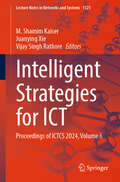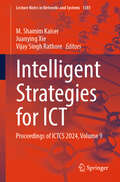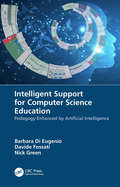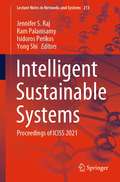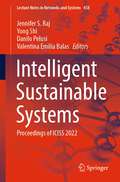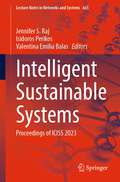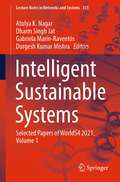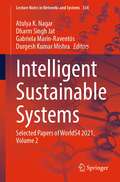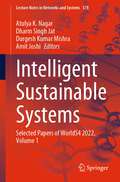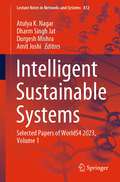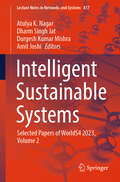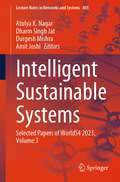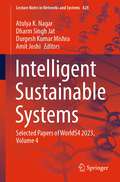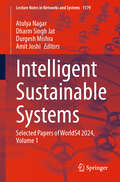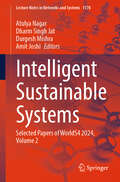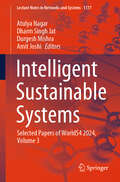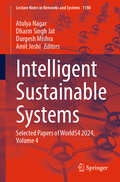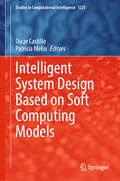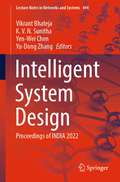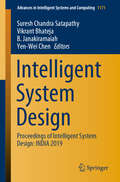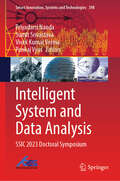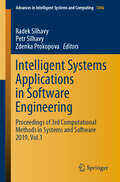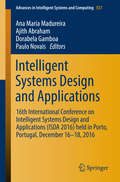- Table View
- List View
Intelligent Strategies for ICT: Proceedings of ICTCS 2024, Volume 4 (Lecture Notes in Networks and Systems #1319)
by Vijay Singh Rathore M. Shamim Kaiser Juanying XieThis book contains best selected research papers presented at ICTCS 2024: Ninth International Conference on Information and Communication Technology for Competitive Strategies. The conference will be held in Jaipur, India during 19 – 21 December 2024. The book covers state-of-the-art as well as emerging topics pertaining to ICT and effective strategies for its implementation for engineering and managerial applications. This book contains papers mainly focused on ICT for computation, algorithms and data analytics and IT security. The work is presented in ten volumes.
Intelligent Strategies for ICT: Proceedings of ICTCS 2024, Volume 5 (Lecture Notes in Networks and Systems #1320)
by Vijay Singh Rathore M. Shamim Kaiser Juanying XieThis book contains best selected research papers presented at ICTCS 2024: Ninth International Conference on Information and Communication Technology for Competitive Strategies. The conference will be held in Jaipur, India during 19 – 21 December 2024. The book covers state-of-the-art as well as emerging topics pertaining to ICT and effective strategies for its implementation for engineering and managerial applications. This book contains papers mainly focused on ICT for computation, algorithms and data analytics and IT security. The work is presented in ten volumes.
Intelligent Strategies for ICT: Proceedings of ICTCS 2024, Volume 6 (Lecture Notes in Networks and Systems #1321)
by Vijay Singh Rathore M. Shamim Kaiser Juanying XieThis book contains best selected research papers presented at ICTCS 2024: Ninth International Conference on Information and Communication Technology for Competitive Strategies. The conference will be held in Jaipur, India during 19 – 21 December 2024. The book covers state-of-the-art as well as emerging topics pertaining to ICT and effective strategies for its implementation for engineering and managerial applications. This book contains papers mainly focused on ICT for computation, algorithms and data analytics and IT security. The work is presented in ten volumes.
Intelligent Strategies for ICT: Proceedings of ICTCS 2024, Volume 9 (Lecture Notes in Networks and Systems #1381)
by Vijay Singh Rathore M. Shamim Kaiser Juanying XieThis book contains best selected research papers presented at ICTCS 2024: Ninth International Conference on Information and Communication Technology for Competitive Strategies. The conference will be held in Jaipur, India during 19 – 21 December 2024. The book covers state-of-the-art as well as emerging topics pertaining to ICT and effective strategies for its implementation for engineering and managerial applications. This book contains papers mainly focused on ICT for computation, algorithms and data analytics and IT security. The work is presented in ten volumes.
Intelligent Support for Computer Science Education: Pedagogy Enhanced by Artificial Intelligence
by Nick Green Barbara Di Eugenio Davide FossatiIntelligent Support for Computer Science Education presents the authors’ research journey into the effectiveness of human tutoring, with the goal of developing educational technology that can be used to improve introductory Computer Science education at the undergraduate level. Nowadays, Computer Science education is central to the concerns of society, as attested by the penetration of information technology in all aspects of our lives; consequently, in the last few years interest in Computer Science at all levels of schooling, especially at the college level, has been flourishing. However, introductory concepts in Computer Science such as data structures and recursion are difficult for novices to grasp. Key Features: Includes a comprehensive and succinct overview of the Computer Science education landscape at all levels of education. Provides in-depth analysis of one-on-one human tutoring dialogues in introductory Computer Science at college level. Describes a scalable, plug-in based Intelligent Tutoring System architecture, portable to different topics and pedagogical strategies. Presents systematic, controlled evaluation of different versions of the system in ecologically valid settings (18 actual classes and their laboratory sessions). Provides a time-series analysis of student behavior when interacting with the system. This book will be of special interest to the Computer Science education community, specifically instructors of introductory courses at the college level, and Advanced Placement (AP) courses at the high school level. Additionally, all the authors’ work is relevant to the Educational Technology community, especially to those working in Intelligent Tutoring Systems, their interfaces, and Educational Data Mining, in particular as applied to human-human pedagogical interactions and to user interaction with educational software.
Intelligent Sustainable Systems: Proceedings of ICISS 2021 (Lecture Notes in Networks and Systems #213)
by Yong Shi Ram Palanisamy Isidoros Perikos Jennifer S. RajThis book features research papers presented at the 4th International Conference on Intelligent Sustainable Systems (ICISS 2021), held at SCAD College of Engineering and Technology, Tirunelveli, Tamil Nadu, India, during February 26–27, 2021. The book discusses the latest research works that discuss the tools, methodologies, practices, and applications of sustainable systems and computational intelligence methodologies. The book is beneficial for readers from both academia and industry.
Intelligent Sustainable Systems: Proceedings of ICISS 2022 (Lecture Notes in Networks and Systems #458)
by Yong Shi Valentina Emilia Balas Danilo Pelusi Jennifer S. RajThis book features research papers presented at the 5th International Conference on Intelligent Sustainable Systems (ICISS 2022), held at SCAD College of Engineering and Technology, Tirunelveli, Tamil Nadu, India, during February 17–18, 2022. The book discusses latest research works that discusses the tools, methodologies, practices, and applications of sustainable systems and computational intelligence methodologies. The book is beneficial for readers from both academia and industry.
Intelligent Sustainable Systems: Proceedings of ICISS 2023 (Lecture Notes in Networks and Systems #665)
by Valentina Emilia Balas Isidoros Perikos Jennifer S. RajThis book features research papers presented at the 6th International Conference on Intelligent Sustainable Systems (ICISS 2023), held at SCAD College of Engineering and Technology, Tirunelveli, Tamil Nadu, India, during February 2–3, 2023. The book reports research results on the development and implementation of novel systems, technologies, and applications that focus on the advancement of sustainable living. The chapters included in this book discuss a spectrum of related research issues such as applications of intelligent computing practices that can have ecological and societal impacts. Moreover, this book emphasizes on the state-of-the-art networked and intelligent technologies that are influencing a promising development in the direction of a long-term sustainable future. The book is beneficial for readers from both academia and industry.
Intelligent Sustainable Systems: Selected Papers of WorldS4 2021, Volume 1 (Lecture Notes in Networks and Systems #333)
by Durgesh Kumar Mishra Atulya K. Nagar Dharm Singh Jat Gabriela Marín-RaventósThis book provides insights of World Conference on Smart Trends in Systems, Security and Sustainability (WS4 2021) which is divided into different sections such as Smart IT Infrastructure for Sustainable Society; Smart Management prospective for Sustainable Society; Smart Secure Systems for Next Generation Technologies; Smart Trends for Computational Graphics and Image Modeling; and Smart Trends for Biomedical and Health Informatics. The proceedings is presented in two volumes. The book is helpful for active researchers and practitioners in the field.
Intelligent Sustainable Systems: Selected Papers of WorldS4 2021, Volume 2 (Lecture Notes in Networks and Systems #334)
by Durgesh Kumar Mishra Atulya K. Nagar Dharm Singh Jat Gabriela Marín-RaventósThis book provides insights of World Conference on Smart Trends in Systems, Security and Sustainability (WS4 2021) which is divided into different sections such as Smart IT Infrastructure for Sustainable Society; Smart Management prospective for Sustainable Society; Smart Secure Systems for Next Generation Technologies; Smart Trends for Computational Graphics and Image Modeling; and Smart Trends for Biomedical and Health Informatics. The proceedings is presented in two volumes. The book is helpful for active researchers and practitioners in the field.
Intelligent Sustainable Systems: Selected Papers of WorldS4 2022, Volume 1 (Lecture Notes in Networks and Systems #578)
by Amit Joshi Durgesh Kumar Mishra Atulya K. Nagar Dharm Singh JatThis book provides insights of World Conference on Smart Trends in Systems, Security and Sustainability (WS4 2022) which is divided into different sections such as Smart IT Infrastructure for Sustainable Society; Smart Management Prospective for Sustainable Society; Smart Secure Systems for Next Generation Technologies; Smart Trends for Computational Graphics and Image Modeling; and Smart Trends for Biomedical and Health Informatics. The proceedings is presented in two volumes. The book is helpful for active researchers and practitioners in the field.
Intelligent Sustainable Systems: Selected Papers of WorldS4 2023, Volume 1 (Lecture Notes in Networks and Systems #812)
by Amit Joshi Atulya K. Nagar Dharm Singh Jat Durgesh MishraThis book provides insights of World Conference on Smart Trends in Systems, Security and Sustainability (WS4 2023) which is divided into different sections such as Smart IT Infrastructure for Sustainable Society; Smart Management Prospective for Sustainable Society; Smart Secure Systems for Next Generation Technologies; Smart Trends for Computational Graphics and Image Modeling; and Smart Trends for Biomedical and Health Informatics. The proceedings is presented in four volumes. The book is helpful for active researchers and practitioners in the field.
Intelligent Sustainable Systems: Selected Papers of WorldS4 2023, Volume 2 (Lecture Notes in Networks and Systems #817)
by Amit Joshi Durgesh Kumar Mishra Atulya K. Nagar Dharm Singh JatThis book provides insights of World Conference on Smart Trends in Systems, Security and Sustainability (WS4 2023) which is divided into different sections such as Smart IT Infrastructure for Sustainable Society; Smart Management Prospective for Sustainable Society; Smart Secure Systems for Next Generation Technologies; Smart Trends for Computational Graphics and Image Modeling; and Smart Trends for Biomedical and Health Informatics. The proceedings is presented in two volumes. The book is helpful for active researchers and practitioners in the field.
Intelligent Sustainable Systems: Selected Papers of WorldS4 2023, Volume 3 (Lecture Notes in Networks and Systems #803)
by Amit Joshi Atulya K. Nagar Dharm Singh Jat Durgesh MishraThis book provides insights of World Conference on Smart Trends in Systems, Security, and Sustainability (WS4 2023) which is divided into different sections such as Smart IT Infrastructure for Sustainable Society; Smart Management Prospective for Sustainable Society; Smart Secure Systems for Next Generation Technologies; Smart Trends for Computational Graphics and Image Modeling; and Smart Trends for Biomedical and Health Informatics. The proceedings is presented in two volumes. The book is helpful for active researchers and practitioners in the field.
Intelligent Sustainable Systems: Selected Papers of WorldS4 2023, Volume 4 (Lecture Notes in Networks and Systems #828)
by Amit Joshi Durgesh Kumar Mishra Atulya K. Nagar Dharm Singh JatThis book provides insights of World Conference on Smart Trends in Systems, Security and Sustainability (WS4 2023) which is divided into different sections such as Smart IT Infrastructure for Sustainable Society; Smart Management Prospective for Sustainable Society; Smart Secure Systems for Next Generation Technologies; Smart Trends for Computational Graphics and Image Modeling; and Smart Trends for Biomedical and Health Informatics. The proceedings is presented in four volumes. The book is helpful for active researchers and practitioners in the field.
Intelligent Sustainable Systems: Selected Papers of WorldS4 2024, Volume 1 (Lecture Notes in Networks and Systems #1179)
by Atulya Nagar Amit Joshi Dharm Singh Jat Durgesh MishraThis book provides insights of World Conference on Smart Trends in Systems, Security and Sustainability (WS4 2024) which is divided into different sections such as Smart IT Infrastructure for Sustainable Society; Smart Management Prospective for Sustainable Society; Smart Secure Systems for Next Generation Technologies; Smart Trends for Computational Graphics and Image Modeling; and Smart Trends for Biomedical and Health Informatics. The proceedings is presented in four volumes. The book is helpful for active researchers and practitioners in the field.
Intelligent Sustainable Systems: Selected Papers of WorldS4 2024, Volume 2 (Lecture Notes in Networks and Systems #1178)
by Atulya Nagar Amit Joshi Dharm Singh Jat Durgesh MishraThis book provides insights of World Conference on Smart Trends in Systems, Security and Sustainability (WS4 2024) which is divided into different sections such as Smart IT Infrastructure for Sustainable Society; Smart Management Prospective for Sustainable Society; Smart Secure Systems for Next Generation Technologies; Smart Trends for Computational Graphics and Image Modeling; and Smart Trends for Biomedical and Health Informatics. The proceedings is presented in four volumes. The book is helpful for active researchers and practitioners in the field.
Intelligent Sustainable Systems: Selected Papers of WorldS4 2024, Volume 3 (Lecture Notes in Networks and Systems #1177)
by Atulya Nagar Amit Joshi Dharm Singh Jat Durgesh MishraThis book provides insights of World Conference on Smart Trends in Systems, Security and Sustainability (WS4 2024) which is divided into different sections such as Smart IT Infrastructure for Sustainable Society; Smart Management Prospective for Sustainable Society; Smart Secure Systems for Next Generation Technologies; Smart Trends for Computational Graphics and Image Modeling; and Smart Trends for Biomedical and Health Informatics. The proceedings is presented in four volumes. The book is helpful for active researchers and practitioners in the field.
Intelligent Sustainable Systems: Selected Papers of WorldS4 2024, Volume 4 (Lecture Notes in Networks and Systems #1180)
by Atulya Nagar Amit Joshi Dharm Singh Jat Durgesh MishraThis book provides insights of World Conference on Smart Trends in Systems, Security and Sustainability (WS4 2024) which is divided into different sections such as Smart IT Infrastructure for Sustainable Society; Smart Management Prospective for Sustainable Society; Smart Secure Systems for Next Generation Technologies; Smart Trends for Computational Graphics and Image Modeling; and Smart Trends for Biomedical and Health Informatics. The proceedings is presented in four volumes. The book is helpful for active researchers and practitioners in the field.
Intelligent System Design Based on Soft Computing Models (Studies in Computational Intelligence #1223)
by Oscar Castillo Patricia MelinThis book comprises a collection of papers focused on intelligent systems based on soft computing techniques. In this book, new directions on intelligent system design based on soft computing models, such as fuzzy logic, neural networks and optimization algorithms, as well as their hybrid combinations, are offered. In addition, the above-mentioned methods are discussed in application areas such as, control and robotics, pattern recognition, medical diagnosis, decision-making, prediction and optimization of complex problems. There are a group of papers with the main theme of type-1, type-2 and type-3 fuzzy logic, which basically consists of papers that propose new concepts and algorithms based on type-1, type-2 and type-3 fuzzy logic and their applications. There is also a set of papers that offer theoretical concepts and applications of meta-heuristics in different areas. There are also some papers that present theory and practice of neural networks in different applications. Finally, there are papers that offer theory and practice of optimization and evolutionary algorithms in different application areas.
Intelligent System Design: Proceedings of INDIA 2022 (Lecture Notes in Networks and Systems #494)
by Yen-Wei Chen Vikrant Bhateja Yu-Dong Zhang K. V. N. SunithaThis book presents a collection of high-quality, peer-reviewed research papers from the 7th International Conference on Information System Design and Intelligent Applications (India 2022), held at BVRIT Hyderabad College of Engineering for Women, Hyderabad, Telangana, India, from February 25 to 26, 2022. It covers a wide range of topics in computer science and information technology, including data mining and data warehousing, high-performance computing, parallel and distributed computing, computational intelligence, soft computing, big data, cloud computing, grid computing and cognitive computing.
Intelligent System Design: Proceedings of Intelligent System Design: INDIA 2019 (Advances in Intelligent Systems and Computing #1171)
by Yen-Wei Chen Suresh Chandra Satapathy Vikrant Bhateja B. JanakiramaiahThis book presents a collection of high-quality, peer-reviewed research papers from the 6th International Conference on Information System Design and Intelligent Applications (INDIA 2019), held at Lendi Institute of Engineering & Technology, India, from 1 to 2 November 2019. It covers a wide range of topics in computer science and information technology, including data mining and data warehousing, high-performance computing, parallel and distributed computing, computational intelligence, soft computing, big data, cloud computing, grid computing and cognitive computing.
Intelligent System and Data Analysis: SSIC 2023 Doctoral Symposium (Smart Innovation, Systems and Technologies #398)
by Sumit Srivastava Vivek Kumar Verma Priyadarsi Nanda Pankaj VyasThis book features original papers from the Doctoral Symposium in 4th International Conference on Smart IoT Systems: Innovations and Computing (SSIC 2023), organized by Manipal University, Jaipur, India, during 26–27 October 2023. It discusses scientific works related to data engineering in the context of computational collective intelligence consisted of interaction between smart devices for smart environments and interactions. The book offers high-quality content and the broad range of topics useful for researchers pursuing advanced studies.
Intelligent Systems Applications in Software Engineering: Proceedings of 3rd Computational Methods in Systems and Software 2019, Vol. 1 (Advances in Intelligent Systems and Computing #1046)
by Radek Silhavy Petr Silhavy Zdenka ProkopovaThis book presents real-world problems and exploratory research that describes novel approaches in software engineering, cybernetics and algorithms in the context of intelligent systems. It constitutes the refereed proceedings of the 3rd Computational Methods in Systems and Software 2019 (CoMeSySo 2019) conference, a groundbreaking online conference that provides an international forum for discussing the latest high-quality research results.
Intelligent Systems Design and Applications
by Ajith Abraham Paulo Novais Ana Maria Madureira Dorabela GamboaThe proceedings of the Third International Conference on Intelligent Systems Design and Applications (ISDA 2003) held in Tulsa, USA, August 10-13. Current research in all areas of computational intelligence is presented including design of artificial neural networks, fuzzy systems, evolutionary algorithms, hybrid computing systems, intelligent agents, and their applications in science, technology, business and commerce. Main themes addressed by the conference are the architectures of intelligent systems, image, speech and signal processing, internet modeling, data mining, business and management applications, control and automation, software agents and knowledge management.
